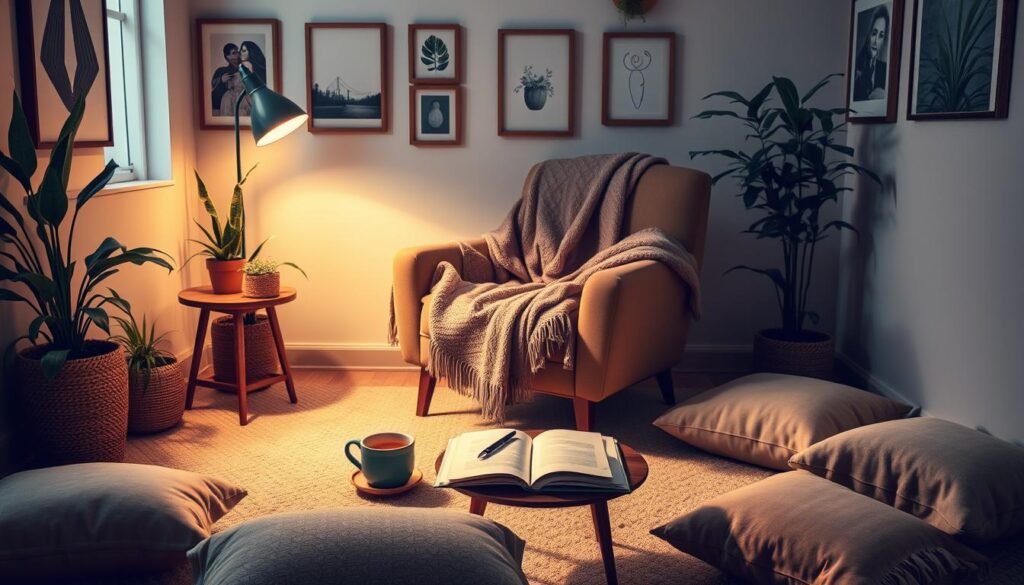Did you know that around 60% of people with anxiety also have depression signs? And nearly half of those with depression suffer from an anxiety disorder too? This fact shows how closely linked these two mental health issues are. It’s essential to know the differences between anxiety and depression to treat them right. We’ll look at their symptoms, causes, and treatment options. This helps people understand anxiety versus depression better. It guides them in managing their mental health more effectively.
Key Takeaways
- Anxiety and depression often co-occur, affecting about 60% of individuals diagnosed with either condition.
- Symptoms of depression must persist most of the day for at least two weeks to qualify for a diagnosis.
- Anxiety disorders can manifest through various forms, including generalized anxiety disorder and panic disorder.
- Common treatments include SSRIs and SNRIs, which target serotonin and norepinephrine in the brain.
- Exercise and meditative practices can be effective strategies for managing both anxiety and depression.
- Understanding the signs and symptoms of each condition can lead to proper treatment and support.
- It is important for individuals to seek help when experiencing ongoing symptoms of anxiety or depression.
Understanding Anxiety and Depression
Anxiety and depression are common mood disorders. They strongly affect how we feel emotionally. Anxiety often brings intense worry and fear. About 19.1% of U.S. adults face anxiety disorders yearly. Generalized Anxiety Disorder (GAD) involves ongoing worry for more than six months. Depression is about deep sadness and hopelessness. It often lasts over two weeks for many people.
About 60% of those with anxiety also have depression. This shows how connected these conditions are. Spotting these issues early can improve support. Women are twice as likely as men to get an anxiety disorder.
Knowing about anxiety and depression is crucial. It helps people get the right support. This promotes mental health awareness and well-being.
| Condition | Prevalence Rate | Key Symptoms |
|---|---|---|
| Anxiety Disorders | 19.1% of adults annually | Excessive worry, fear, panic attacks |
| Depression | 6.7% of adults annually | Persistent sadness, hopelessness, loss of interest |
| Co-occurrence of Both | 41.6% during a 12-month period | Mix of anxiety and depressive symptoms |
What Is Anxiety?
Anxiety is excessive worry and fear that disrupts someone’s life. It’s important to know what anxiety is because it can really affect people’s lives. Anxiety disorders can damage both mental and physical health. About 30% of adults might face anxiety disorders in their life, so knowing the symptoms and types is key.
Defining Anxiety Disorders
Anxiety disorders come in different types and cause a lot of fear or worry. They might make doing well at work or school hard, and can hurt personal relationships. There are many common anxiety disorders, and each requires a specific diagnosis and treatment. Knowing the details helps people get the right help.
Common Types of Anxiety Disorders
Several types of anxiety disorders exist, including:
- Generalized Anxiety Disorder (GAD): Affects 2.9% of adults with chronic worry about various issues.
- Social Anxiety Disorder (SAD): Impacts about 7% of U.S. adults, causing intense fear in social settings.
- Panic Disorder: Hits 2% – 3% of adults with sudden panic attacks, including palpitations and fear of losing control.
- Specific Phobia: Seen in 8% – 12% of U.S. adults, causing extreme fear of certain objects or situations.
- Obsessive-Compulsive Disorder (OCD): A long-term condition with unwanted thoughts and repetitive actions.
- Post-Traumatic Stress Disorder (PTSD): Comes after a shocking event, leading to severe anxiety and flashbacks.
- Agoraphobia: Fear of places where escape is tough, affecting 1% to 1.7% of people globally.
- Separation Anxiety Disorder: Usually seen in 4% of children but can continue into adulthood.
- Selective Mutism: Affects 0.03% – 1.9% of people, causing silence in certain social situations.
Knowing these common types helps in identifying symptoms and finding the right treatment. Each person’s experience with anxiety is different, showing the need for unique treatment plans.
| Type of Anxiety Disorder | Prevalence in Adults | Key Symptoms |
|---|---|---|
| Generalized Anxiety Disorder (GAD) | 2.9% | Chronic worry, trouble sleeping, fatigue |
| Social Anxiety Disorder (SAD) | 7% | Fear of social interactions, embarrassment |
| Panic Disorder | 2% – 3% | Panic attacks, heart palpitations, fear of losing control |
| Specific Phobia | 8% – 12% | Intense fear of specific objects or situations |
| OCD | Varies | Obsessive thoughts, compulsive behaviors |
| PTSD | Varies | Flashbacks, severe anxiety, emotional distress |
What Is Depression?
Depression is a severe mental health issue marked by constant sadness, loss of interest, and low energy. It affects feelings, social life, and thinking. Knowing the different depression types is key for proper diagnosis and treatment.
The Nature of Depression
Depression’s roots are complex. It can start from genetics, brain chemistry, or tough life events. Symptoms like feeling worthless, too much guilt, and sleep problems must last two weeks for a diagnosis. It’s important to get help early.
Without treatment, depression might cause anxiety disorders.
Types of Depression
There are various forms of depression, each needing a unique treatment plan. Some common ones include:
- Major Depressive Disorder (MDD): This causes deep sadness and takes over daily life.
- Persistent Depressive Disorder (Dysthymia): A long-lasting mood disorder with ongoing sadness and motivational issues.
- Seasonal Affective Disorder (SAD): This type hits at the same time yearly, often in winter.
- Postpartum Depression: New moms face this, which brings emotional and psychological struggles.
- Psychotic Depression: This severe form includes depression and psychotic symptoms like seeing things.
Understanding these types helps in finding the right treatment and support for recovery.
Symptoms of Anxiety
It’s vital to know the symptoms of anxiety to address this common mental health issue. Anxiety signs include mental and physical types. Knowing them helps people seek help early.
Mental Symptoms of Anxiety
Mental anxiety symptoms can be:
- Excessive worry about daily stuff
- Struggling to focus on tasks
- Overwhelming racing thoughts
- Feeling detached or unreal
Persistent signs like these might point to an anxiety disorder. Professional help could be needed then.
Physical Symptoms of Anxiety
Physical signs of anxiety include:
- Heart beating fast or irregularly
- Hard to breathe or short breaths
- Feeling dizzy or lightheaded
- Muscles feeling tense and uncomfortable
Knowing both mental and physical symptoms helps people understand their anxiety better. It shows the importance of treating it from all angles.
| Symptoms Type | Mental Symptoms | Physical Symptoms |
|---|---|---|
| Generalized Anxiety Disorder | Excessive worry | Increased heart rate |
| Social Anxiety Disorder | Fear of social situations | Tension in muscles |
| Panic Disorder | Racing thoughts | Shortness of breath |
| Phobias | Intense fear or anxiety | Dizziness |
| Obsessive-Compulsive Disorder | Intrusive thoughts | Palpitations |
| Posttraumatic Stress Disorder | Feelings of detachment | Muscle tension |
Knowing these signs helps people grasp anxiety’s complexity. It encourages better management and support.
Symptoms of Depression
It’s important to know the symptoms of depression for early help. These signs include mental and physical symptoms that greatly affect daily life.
Mental Symptoms of Depression
Mental symptoms make emotional life hard. These include:
- Feelings of hopelessness and despair
- Persistent irritability and agitation
- Low energy levels and fatigue
- A marked loss of interest in activities once enjoyed
- Difficulty concentrating or making decisions
Physical Symptoms of Depression
Physical symptoms often go with emotional pain, harming daily function. Main physical symptoms are:
- Significant changes in appetite, causing weight loss or gain
- Sleep problems like insomnia or sleeping too much
- Unexplained body aches and pains
- General sluggishness
Knowing these depression symptoms is key. People with these signs should talk to a health professional to understand their situation and find the right treatment.
Key Differences Between Anxiety and Depression
Anxiety and depression affect emotions differently. It’s crucial to know the differences for the right treatment. Anxiety is mostly about fear, worry, and panic in day-to-day life. Around 1 in 5 adults in North America face anxiety disorders. This impacts their social and work life greatly.
Anxiety symptoms include sweating, fast heartbeat, and trouble sleeping. These show the body’s alert state. Chronic stress and anxiety are closely linked. Without treatment, anxiety can get worse, causing more severe problems.
Depression brings a deep sadness and a loss of interest in fun activities. It’s reported that over 6% of Canadians deal with depression every year. Symptoms can last over two weeks, hurting everyday life, friendships, and social life. Those with depression might also have more health issues, like chronic diseases.

| Aspect | Anxiety | Depression |
|---|---|---|
| Emotional Experience | Pervasive fear and worry | Persistent sadness and loss of interest |
| Physical Symptoms | Increased heart rate, sweating, panic attacks | Fatigue, changes in appetite, sleep disturbances |
| Functional Impact | Limits work and social interactions | Disrupts daily life significantly |
| Co-occurrence | Up to 50% also experience depression | Commonly experienced alongside anxiety |
It’s key to recognize these differences for the right treatment. Both conditions need care. Understanding their unique signs helps in better mental health management.
Anxiety vs Depression: Co-occurrence and Relationships
Anxiety and depression often occur together, posing a big challenge to public health. Almost half the people with major depression also struggle with severe anxiety. This shows why it’s crucial to understand how these conditions affect each other. Having anxiety can also increase the risk of getting depression, pointing to a possible cycle between them.
The Overlap between Anxiety and Depression
Some groups, like those with post-traumatic stress disorder (PTSD), are at higher risk for depression. Anxiety can make treatment more difficult. If it’s not addressed, symptoms can get worse and may lead to depression. In kids and teens, depression might look like irritability. In adults, it often shows up as hopelessness.
How One Can Influence the Other
The way anxiety impacts depression is well known. Having both can lead to worse outcomes, like more disability and a higher suicide risk, than just one disorder. Treatments often include Cognitive Behavioral Therapy (CBT) to address root causes. Medications like SSRIs are also used to help with both conditions.
Additionally, things like exercise and relaxation techniques can really improve life for those dealing with both issues. These methods help with symptoms and improve overall mental health. It’s clear that people facing both anxiety and depression need care that considers the complex relationship between these common mental health problems.
Treatment Options for Anxiety and Depression
Treatment for anxiety and depression includes many strategies to help improve well-being. It’s common for people to use both medication and therapy. Finding the right treatments can greatly improve life quality.
Medications for Anxiety and Depression
For anxiety, medications like SSRIs and SNRIs are often used. They help with both anxiety and depression symptoms. About 60% of people get better with SSRIs. SNRIs also offer good help.
Here’s a quick look at some common medications:
| Medication Type | Starting Dose | Common Use |
|---|---|---|
| SSRIs (e.g., Citalopram) | 20 mg daily | Anxiety and depression |
| SSRIs (e.g., Escitalopram) | 5-10 mg daily | Anxiety and depression |
| SNRIs (e.g., Milnacipran) | 12.5 mg daily | Anxiety and depression |
| SNRIs (e.g., Venlafaxine) | 37.5-75 mg daily | Anxiety and depression |
| Benzodiazepines | Variable | Short-term relief |
Medications impact everyone differently. SSRIs might take up to six weeks to work. Benzodiazepines can work quickly, in 30 to 60 minutes. But, it’s crucial to watch for side effects like an increased risk of suicide, especially in young adults.
Therapy Approaches: CBT and Beyond
CBT is a key therapy for treating anxiety and depression. It helps change negative thoughts to reduce distress. About 70% of people see symptom reduction after regular therapy.
Other helpful therapy methods include:
- Interpersonal therapy
- Problem-solving therapy
Both medication and therapy are important. They work best when used together, especially for severe symptoms. Addressing both mind and body can significantly improve mental health.

Coping Strategies for Anxiety and Depression
To manage anxiety and depression well, you need real coping techniques. These methods help take care of your mental health and improve your overall happiness. Exercise is key. It’s advised to do moderate exercises, like brisk walking, for about 2½ hours weekly. This significantly lowers anxiety and stress.
Eating well is vital. This means eating regularly and cutting down on alcohol and caffeine. Missing meals can make you feel more anxious. Plus, sleeping well for 7-9 hours each night boosts your mental wellbeing and your ability to cope. It might take 4 to 8 weeks to get better coordination and fitness with regular exercise.
- Implement deep breathing techniques or progressive counting to manage immediate anxiety.
- Engage in community activities or volunteering to develop a support network, which can enhance mental health management.
- Incorporate humor and a positive attitude into daily life to help disrupt negative thought patterns.
- Practice journaling to identify personal triggers of anxiety and develop tailored self-help techniques.
Studies show that being active can cut anxiety and depression symptoms by up to 30%. This shows how closely exercise is linked to better mental health. For those dealing with depression, cognitive behavioral therapy (CBT) can be really helpful, with success rates of 50% to 75%. Using these coping strategies can help people face their mental health issues more strongly.
Recognizing When to Seek Help
Knowing when to get help for feeling anxious or really down is key. Often, people feel so overwhelmed that it messes with their daily lives. This could mean having a hard time focusing, which affects school or work.

Different groups face these issues in their own ways. Women get diagnosed with depression more than men. For those in the LGBTQI+ community, depression rates are higher, so getting help early is crucial. Kids and teens might seem more irritable than sad. And some older people might have memory problems, which others might just think is due to getting older.
For major depression, the signs need to last at least two weeks and mess with daily life. Persistent depressive disorder is less intense but lasts for two years or more. Seasonal changes can trigger seasonal affective disorder, causing sadness in winter.
During hard times, like health scares or big changes in society, finding support is vital. Staying connected with loved ones helps beat feelings of being alone. Writing in a journal is also a good way to deal with your feelings.
Screens for mood, like the PHQ-9 for feeling down or GAD-7 for worries, help decide if it’s time to see a professional. For immediate help, the National Suicide Prevention Line at 800-273-TALK (8255) is there 24/7.
It’s just as important to know when to get help for anxiety. By spotting the signs early and getting what they mean, people can take steps to feel better and improve their mental health.
Importance of Mental Health Awareness
Mental health awareness is key to addressing anxiety and depression. It helps in reducing stigma linked to mental health issues. Conversations about mental health allow people to seek help and get better intervention.
About 31.1% of people will face anxiety at some time in their lives. Nearly half of those with depression also have anxiety. This shows how common these issues are and why understanding matters.
Around 60% of adults with anxiety don’t get help. This shows a huge gap in awareness. Educating people on symptoms, treatment options, and when to seek help is vital.
| Statistic | Understanding |
|---|---|
| 31.1% | Population with anxiety disorders |
| 50% | Individuals with depression also having anxiety disorders |
| 60% | Adults with anxiety disorders who do not receive treatment |
| 25% | Adults with comorbid anxiety and depression |
Supporting mental health awareness can change society. It normalizes talking about mental health. This reduces stigma and helps people get support and treatment.
Conclusion
In summing up anxiety vs depression, we see they are similar but different mental health issues. Stats show 40% feel anxious and 30% feel sad. The 12-month data tells us 18.1% face anxiety and 9.5% face mood problems. It’s key we spot and manage these well.
It’s crucial to know both what anxiety and depression share and how they differ. This helps choose the right treatment. Data reveal that serious anxiety or depression affects our life quality. This shows why understanding mental health and having support matters. Recognizing these issues helps people work towards a better life.
Awareness and knowledge about anxiety and depression help fight stigma. They push people to get help. With the right support and ways to cope, those struggling can get back on their feet. They can boost their mental health for a brighter future.